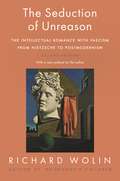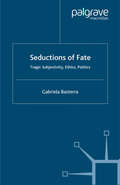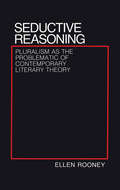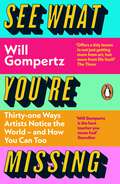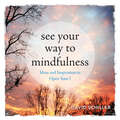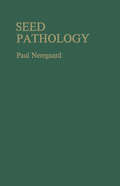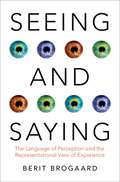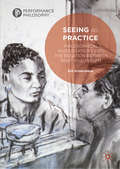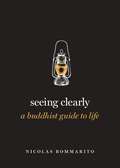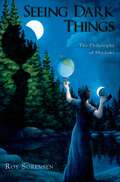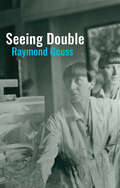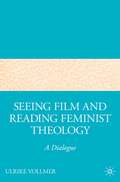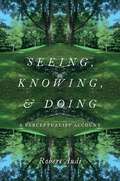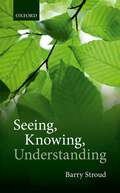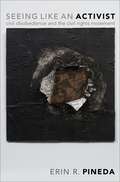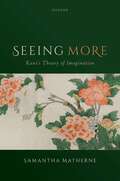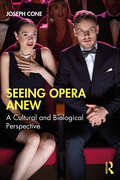- Table View
- List View
The Seduction of Unreason: The Intellectual Romance with Fascism from Nietzsche to Postmodernism, Second Edition
by Richard WolinEver since the shocking revelations of the fascist ties of Martin Heidegger and Paul de Man, postmodernism has been haunted by the specter of a compromised past. In this intellectual genealogy of the postmodern spirit, Richard Wolin shows that postmodernism’s infatuation with fascism has been extensive and widespread. He questions postmodernism’s claim to have inherited the mantle of the Left, suggesting instead that it has long been enamored with the opposite end of the political spectrum. Wolin reveals how, during in the 1930s, C. G. Jung, Hans-Georg Gadamer, Georges Bataille, and Maurice Blanchot were seduced by fascism's promise of political regeneration and how this misapprehension affected the intellectual core of their work. The result is a compelling and unsettling reinterpretation of the history of modern thought. In a new preface, Wolin revisits this illiberal intellectual lineage in light of the contemporary resurgence of political authoritarianism.
Seductions of Fate: Tragic Subjectivity, Ethics, Politics
by G. BasterraIf the tragic interpretation of experience is still so current, despite its disastrous ethical consequences, it is because it shapes our subjectivity. Instead of contradicting the ideals of autonomy and freedom, a modern subjectivity based on self-victimization in effect enables them. By embracing subjection to an alienating other (the Law, Power) the autonomous subject protects its sameness from the disruption of real people. Seductions of Fate stages a dialogue between this tragic agent of political emancipation and the unconditional ethical demands it seeks to evade.
Seductive Reasoning: Pluralism as the Problematic of Contemporary Literary Theory
by Ellen RooneySeductive Reasoning takes a provocative look at contemporary Anglo-American literary theory, calling into question the critical consensus on pluralism's nature and its status in literary studies. Drawing on the insights of Marxist and feminist critical theory and on the works of Althusser, Derrida, and Foucault, Rooney reads the pluralist’s invitation to join in a "dialogue" as a seductive gesture. Critics who respond find that they must seek to persuade all of their potential readers. Rooney examines pluralism as a form of logic in the work of E. D. Hirsch, as a form of ethics for Wayne Booth, as a rhetoric of persuasion in the books of Stanley Fish. For Paul de Man, Rooney argues, pluralism was a rhetoric of tropes just as it was, for Fredric Jameson, a form of politics.
See What You're Missing: 31 Ways Artists Notice the World – and How You Can Too
by Will GompertzHow might we see ourselves more clearly? Consult Rembrandt.Who can encourage us to see more intimately? Tracey Emin is the expert.What about helping us see through pain? Look no further than Frida Kahlo.Too often we move through life on autopilot, blind to the life-affirming beauty of our strangeworld. But it doesn’t have to be this way.In this masterclass on how an appreciation of art can help us lead fuller lives, Will Gompertz takes us into the minds and work of thirty-one astounding artists. Each has their own unique way of seeing: with their help, we learn how to expand our own vision of life and its endless possibilities – how to look, feel and think more clearly.‘Offers a tide lesson in not just getting more from art, but more from life itself’ The Times‘Art can amaze us into changing our minds. This remarkable book teaches us how’ Es Devlin‘Highly engaging and thought-provoking’ Philip Hook, author of Breakfast at Sotheby’s‘Will Gompertz is the best teacher you never had’ Guardian
See Your Way to Mindfulness: Ideas and Inspiration to Open Your I
by David SchillerSeeing, really seeing, is like meditation. In a world filled with distraction, seeing mindfully is a way to pay attention, to hit pause and find calm by focusing on what&’s directly in front of us. See Your Way to Mindfulness is a gift book of inspiration and instruction to help readers open their eyes—and their &“I&’s.&” Written by David Schiller, author of the national bestseller The Little Zen Companion, it&’s a collection of quotes, prompts, exercises, meditations—married with photographs and drawings that bring the words to life. The quotes are from artists, Buddhists, philosophers, poets, and more, all centered on the theme of how &“The real voyage of discovery consists not in seeking new landscapes, but in having new eyes&” (Marcel Proust). The short, playful exercises and prompts—like Seeing in the Rain, Eye Spy with My Open I, Spend 30 Minutes Taking a Five-Minute Walk, Get Lost—are designed to disrupt routine and inspire readers to see for themselves. Some of the exercises involve drawing, writing, and taking photographs, opening a path to creativity as well as showing how to engage in the moment. Think of it as the Zen of seeing—a new way to look at the world afresh and rediscover joy in the everyday.
Seeing and Saying: The Language of Perception and the Representational View of Experience (Philosophy of Mind Series)
by Berit BrogaardImagine you are sitting at Starbuck glancing at the blue coffee mug in front of you. The mug is blue on the outside, white on the inside. It's large for a mug. And it's nearly full of freshly made coffee. In the envisaged case, you see all those aspects of the scene in front of you, but it remains a question of ferocious debate whether the visual experience that makes up your seeing is a direct "perceptual" relation between you and your environment or a psychology state that has a content that represents the mug. If your experience involves an external "perceptual" relation to an external, mind-independent object, it is unlike familiar mental states such as belief and desire states, which are widely considered psychological states with a representational content that stands between you and the external world. Your belief that the coffee mug in front of you is blue has a content that represents the coffee mug as being blue. Your desire that the coffee in the mug is still hot has a content that represents a state of affairs that may or may not in fact obtain, namely the state of affairs that the coffee in the mug is still hot. In this book, Brit Brogaard defends the view that visual experience is like belief in having a representational content. Her defense differs from most previous defenses of this view in that it begins by looking at the language of ordinary speech. She provides a linguistic analysis of what we say when we say that things look a certain way or that the world appears to us to be a certain way. She then argues that this analysis can be used to argue for the view that visual experience has a representation content that mediates between you and the world when you visually perceive.
Seeing and Saying: The Language of Perception and the Representational View of Experience (Philosophy of Mind Series)
by Berit BrogaardImagine you are sitting at Starbuck glancing at the blue coffee mug in front of you. The mug is blue on the outside, white on the inside. It's large for a mug. And it's nearly full of freshly made coffee. In the envisaged case, you see all those aspects of the scene in front of you, but it remains a question of ferocious debate whether the visual experience that makes up your seeing is a direct "perceptual" relation between you and your environment or a psychology state that has a content that represents the mug. If your experience involves an external "perceptual" relation to an external, mind-independent object, it is unlike familiar mental states such as belief and desire states, which are widely considered psychological states with a representational content that stands between you and the external world. Your belief that the coffee mug in front of you is blue has a content that represents the coffee mug as being blue. Your desire that the coffee in the mug is still hot has a content that represents a state of affairs that may or may not in fact obtain, namely the state of affairs that the coffee in the mug is still hot. In this book, Brit Brogaard defends the view that visual experience is like belief in having a representational content. Her defense differs from most previous defenses of this view in that it begins by looking at the language of ordinary speech. She provides a linguistic analysis of what we say when we say that things look a certain way or that the world appears to us to be a certain way. She then argues that this analysis can be used to argue for the view that visual experience has a representation content that mediates between you and the world when you visually perceive.
Seeing as Practice: Philosophical Investigations into the Relation Between Sight and Insight (Performance Philosophy)
by Eva SchuermannThis study provides an overview of philosophical questions relating to sight and vision. It discusses the intertwinement of seeing and ways of seeing against the background of an entirely different theoretical framework.Seeing is both a proven means of acquiring information and a personality-specific way of disclosing the apparent, perceptible world, conditioned by individual and cultural variations. In a peculiar way, the eye holds a middle position between inside and outside of the self and its relations towards itself and others. This book provides a way out of false alternatives by offering a third way with reference to concrete cases of aesthetical and ethical experiences. It will be of particular interest to scholars of the phenomenology and philosophy of perception and it will be valuable to students of philosophy, cultural studies and art.
Seeing Clearly: A Buddhist Guide to Life (Guides to the Good Life Series)
by Nicolas BommaritoMany of us, even on our happiest days, struggle to quiet the constant buzz of anxiety in the background of our minds. All kinds of worries--worries about losing people and things, worries about how we seem to others--keep us from peace of mind. Distracted or misled by our preoccupations, misconceptions, and, most of all, our obsession with ourselves, we don't see the world clearly--we don't see the world as it really is. In our search for happiness and the good life, this is the main problem. But luckily there is a solution, and on the path to understanding it, we can make use of the rich and varied teachings that have developed over centuries of Buddhist thought. With clarity and compassion, Nicolas Bommarito explores the central elements of centuries of Buddhist philosophy and practice, explaining how they can improve your life and teach you to live without fear. Mining important texts and lessons for practical guidance, he provides a friendly guide to the very practical goals that underpin Buddhist philosophy. After laying out the basic ideas, Bommarito walks readers through a wide range of techniques and practices we can adopt to mend ingrained habits. Rare for its exploration of both the philosophy that motivates Buddhism and its practical applications, this is a compassionate guide to leading a good life that anyone can follow.
Seeing Clearly: A Buddhist Guide to Life (Guides to the Good Life Series)
by Nicolas BommaritoMany of us, even on our happiest days, struggle to quiet the constant buzz of anxiety in the background of our minds. All kinds of worries--worries about losing people and things, worries about how we seem to others--keep us from peace of mind. Distracted or misled by our preoccupations, misconceptions, and, most of all, our obsession with ourselves, we don't see the world clearly--we don't see the world as it really is. In our search for happiness and the good life, this is the main problem. But luckily there is a solution, and on the path to understanding it, we can make use of the rich and varied teachings that have developed over centuries of Buddhist thought. With clarity and compassion, Nicolas Bommarito explores the central elements of centuries of Buddhist philosophy and practice, explaining how they can improve your life and teach you to live without fear. Mining important texts and lessons for practical guidance, he provides a friendly guide to the very practical goals that underpin Buddhist philosophy. After laying out the basic ideas, Bommarito walks readers through a wide range of techniques and practices we can adopt to mend ingrained habits. Rare for its exploration of both the philosophy that motivates Buddhism and its practical applications, this is a compassionate guide to leading a good life that anyone can follow.
Seeing Dark Things: The Philosophy of Shadows
by Roy SorensenIf a spinning disk casts a round shadow does this shadow also spin? When you experience the total blackness of a cave, are you seeing in the dark? Or are you merely failing to see anything (just like your blind companion)? Seeing Dark Things uses visual riddles to explore our ability to see things that do not reflect light. Shadows and holes are anomalies for the causal theory of perception, which states that anything we see must be a cause of what we see. This requirement neatly explains why you see the front of a book's jacket and not its rear when you look at it face-on. However, the causal theory has trouble explaining how you manage to see the black letters on its surface. The letters are made visible by the light they fail to reflect rather than by the light they reflect. Nevertheless, Roy Sorensen defends the causal theory of perception by treating absences as causes. His fourteen chapters draw heavily on common sense and psychology to vindicate the assumption that we perceive absences. Seeing Dark Things is philosophy for the eye. It contains fifty-nine figures designed to prompt visual judgment. Sorensen proceeds bottom-up from observation rather than top-down from theory. He regards detailed analysis of absences as premature; he hopes a future theory will refine the pictorial thinking stimulated by the book's riddles. Just as the biologist pursues genetics with fruit flies, the metaphysician can study absences by means of shadows. Shadows are metaphysical amphibians with one foot on the terra firma of common sense and the other in the murky waters of nonbeing. Sorensen portrays the causal theory of perception's confrontation with the shadows as a triumph against alien attack - a victory that deepens a theory that resonates profoundly with common sense and science. In sum, Seeing Dark Things is an unorthodox defense of an orthodox theory. "Seeing Dark Things is an adventurous philosophical exercise in the ontology and epistemology of the commonsense world. Its treatment of the many puzzles that surround such putative 'negative' entities as shadows and holes will make it a classic on the literature on privations for many yeas to come. The book is also a wonderful example of how philosophy can be done without falling into the traps of the academic rigmarole. Sorensen is truly unique in his capacity to bring together classic philosophers, contemporary authors, and ticklish anecdotes." - Achille Varzi, Columbia University "This is a wonderful book, full of a profound, unsettling cleverness and weirdly satisfying counter-intuitiveness that the subject requires...a great book." - Richard Marshall, Bookforum "Sorensen is an extraordinarily fertile and imaginative philosopher, drawing widely on philosophy, physics, biology and vision science to mine his chosen quarry. His arguments, anecdotes and examples are always engaging. Add them to his effortless style and you have a rare commodity - a book of serious philosophy that many non-professionals will enjoy." - Ian Phillips, Times Literary Supplement "Sorensen's book is certainly fascinating and richly thought-provoking... he argues carefully and clearly in favour of his key claims, all of which merit very serious consideration, even if they sometimes provoke one to construct and defend alternative views. That, however, is surely the hallmark of the very best kind of philosophy writing. Seeing Dark Things is a model of this kind." - E.J. Lowe, Philosophy
Seeing Dark Things: The Philosophy of Shadows
by Roy SorensenIf a spinning disk casts a round shadow does this shadow also spin? When you experience the total blackness of a cave, are you seeing in the dark? Or are you merely failing to see anything (just like your blind companion)? Seeing Dark Things uses visual riddles to explore our ability to see things that do not reflect light. Shadows and holes are anomalies for the causal theory of perception, which states that anything we see must be a cause of what we see. This requirement neatly explains why you see the front of a book's jacket and not its rear when you look at it face-on. However, the causal theory has trouble explaining how you manage to see the black letters on its surface. The letters are made visible by the light they fail to reflect rather than by the light they reflect. Nevertheless, Roy Sorensen defends the causal theory of perception by treating absences as causes. His fourteen chapters draw heavily on common sense and psychology to vindicate the assumption that we perceive absences. Seeing Dark Things is philosophy for the eye. It contains fifty-nine figures designed to prompt visual judgment. Sorensen proceeds bottom-up from observation rather than top-down from theory. He regards detailed analysis of absences as premature; he hopes a future theory will refine the pictorial thinking stimulated by the book's riddles. Just as the biologist pursues genetics with fruit flies, the metaphysician can study absences by means of shadows. Shadows are metaphysical amphibians with one foot on the terra firma of common sense and the other in the murky waters of nonbeing. Sorensen portrays the causal theory of perception's confrontation with the shadows as a triumph against alien attack - a victory that deepens a theory that resonates profoundly with common sense and science. In sum, Seeing Dark Things is an unorthodox defense of an orthodox theory. "Seeing Dark Things is an adventurous philosophical exercise in the ontology and epistemology of the commonsense world. Its treatment of the many puzzles that surround such putative 'negative' entities as shadows and holes will make it a classic on the literature on privations for many yeas to come. The book is also a wonderful example of how philosophy can be done without falling into the traps of the academic rigmarole. Sorensen is truly unique in his capacity to bring together classic philosophers, contemporary authors, and ticklish anecdotes." - Achille Varzi, Columbia University "This is a wonderful book, full of a profound, unsettling cleverness and weirdly satisfying counter-intuitiveness that the subject requires...a great book." - Richard Marshall, Bookforum "Sorensen is an extraordinarily fertile and imaginative philosopher, drawing widely on philosophy, physics, biology and vision science to mine his chosen quarry. His arguments, anecdotes and examples are always engaging. Add them to his effortless style and you have a rare commodity - a book of serious philosophy that many non-professionals will enjoy." - Ian Phillips, Times Literary Supplement "Sorensen's book is certainly fascinating and richly thought-provoking... he argues carefully and clearly in favour of his key claims, all of which merit very serious consideration, even if they sometimes provoke one to construct and defend alternative views. That, however, is surely the hallmark of the very best kind of philosophy writing. Seeing Dark Things is a model of this kind." - E.J. Lowe, Philosophy
Seeing Double
by Raymond GeussThe world is never going to make complete sense to us, yet we find that conclusion almost impossible to accept. Can we live, and feel at home, in a world composed at best of incompatible fragments of meaning?This is the theme that runs through this collection of essays by Raymond Geuss. Drawing on a characteristically wide range of insights from moral and political philosophy, history, and aesthetics, he addresses topics such as knowledge (of self, the world, and others), language, the visual and the auditory, authority, hope, and the success and failure of life projects. He argues that, to get by in our bewildering world, we must embrace the virtue of ‘double vision’: that is, immersing ourselves in and learning the ways of the culture surrounding us, even as we feel alienated from it. Together the essays explore some of the consequences of abandoning the idea of a unitary view of the world, while at the same time trying to avoid quietism.Seeing Double is a compelling collection of work by one of the world’s most versatile and creative philosophers.
Seeing Double
by Raymond GeussThe world is never going to make complete sense to us, yet we find that conclusion almost impossible to accept. Can we live, and feel at home, in a world composed at best of incompatible fragments of meaning?This is the theme that runs through this collection of essays by Raymond Geuss. Drawing on a characteristically wide range of insights from moral and political philosophy, history, and aesthetics, he addresses topics such as knowledge (of self, the world, and others), language, the visual and the auditory, authority, hope, and the success and failure of life projects. He argues that, to get by in our bewildering world, we must embrace the virtue of ‘double vision’: that is, immersing ourselves in and learning the ways of the culture surrounding us, even as we feel alienated from it. Together the essays explore some of the consequences of abandoning the idea of a unitary view of the world, while at the same time trying to avoid quietism.Seeing Double is a compelling collection of work by one of the world’s most versatile and creative philosophers.
Seeing Film and Reading Feminist Theology: A Dialogue
by U. VollmerUsing feminist theory and examining films that describe women artists who see others through the lens of feminist theology, this book puts forward an original view of the act of seeing as an ethical activity - a gesture of respect for and belief in another person's visible and invisible sides, which guarantees the safekeeping of the Other's memory.
Seeing, Knowing, and Doing: A Perceptualist Account
by Robert AudiPerception is basic for human knowledge and a major concern of both epistemology and the philosophy of mind. The scholarship in this area, however, has left two important aspects of perception underexplored: its relevance to understanding a priori knowledge-traditionally conceived as independent of perception-and its role in human action. This book provides a full-scale account of perception, a theory of the a priori, and an account of how perception guides action. In exploring perception and action, it clarifies the relation between action and practical reasoning, the notion of rational action, and the relation between knowledge of the practical (of how things are done) and practical knowledge (knowing how to do things). In the first part of the book, Robert Audi lays out a theory of perception as experiential, representational, and causally connected with its objects. He argues that perception is a discriminative response to its objects; it embodies phenomenally distinctive elements; and it yields rich information that underlies human knowledge. Part Two presents a theory of self-evidence and the a priori. Audi's theory is perceptualist in that it explicates the apprehension of a priori truths by articulating its parallels to perception. The theory also unifies empirical and a priori knowledge by clarifying their reliable causal connections with their objects-connections many have thought impossible for a priori knowledge. The final part explores how perception guides action, the role of propositional knowledge in our abilities to do what we know how to do, the nature of reasons for action, the role of inference in determining it, and the overall conditions for its rationality. Addressing longstanding questions left unaddressed in the current literature, Audi's comprehensive theory of perception will appeal to scholars and students interested in philosophy of perception, mind, and epistemology.
Seeing, Knowing, and Doing: A Perceptualist Account
by Robert AudiPerception is basic for human knowledge and a major concern of both epistemology and the philosophy of mind. The scholarship in this area, however, has left two important aspects of perception underexplored: its relevance to understanding a priori knowledge-traditionally conceived as independent of perception-and its role in human action. This book provides a full-scale account of perception, a theory of the a priori, and an account of how perception guides action. In exploring perception and action, it clarifies the relation between action and practical reasoning, the notion of rational action, and the relation between knowledge of the practical (of how things are done) and practical knowledge (knowing how to do things). In the first part of the book, Robert Audi lays out a theory of perception as experiential, representational, and causally connected with its objects. He argues that perception is a discriminative response to its objects; it embodies phenomenally distinctive elements; and it yields rich information that underlies human knowledge. Part Two presents a theory of self-evidence and the a priori. Audi's theory is perceptualist in that it explicates the apprehension of a priori truths by articulating its parallels to perception. The theory also unifies empirical and a priori knowledge by clarifying their reliable causal connections with their objects-connections many have thought impossible for a priori knowledge. The final part explores how perception guides action, the role of propositional knowledge in our abilities to do what we know how to do, the nature of reasons for action, the role of inference in determining it, and the overall conditions for its rationality. Addressing longstanding questions left unaddressed in the current literature, Audi's comprehensive theory of perception will appeal to scholars and students interested in philosophy of perception, mind, and epistemology.
Seeing, Knowing, Understanding: Philosophical Essays
by Barry StroudBarry Stroud presents nineteen of his philosophical essays written since 2001, on topics to do with knowing, seeing, and understanding. He discusses the nature of philosophy, sense experience, the possibility of perceptual knowledge, intentional action and self-knowledge, the reality of the colours of things, alien thought and the limits of understanding, moral knowledge, meaning, use, and understanding of language.
Seeing, Knowing, Understanding: Philosophical Essays
by Barry StroudBarry Stroud presents nineteen of his philosophical essays written since 2001, on topics to do with knowing, seeing, and understanding. He discusses the nature of philosophy, sense experience, the possibility of perceptual knowledge, intentional action and self-knowledge, the reality of the colours of things, alien thought and the limits of understanding, moral knowledge, meaning, use, and understanding of language.
Seeing Like an Activist: Civil Disobedience and the Civil Rights Movement
by Erin R. PinedaThere are few movements more firmly associated with civil disobedience than the Civil Rights Movement. In the mainstream imagination, civil rights activists eschewed coercion, appealed to the majority's principles, and submitted willingly to legal punishment in order to demand necessary legislative reforms and facilitate the realization of core constitutional and democratic principles. Their fidelity to the spirit of the law, commitment to civility, and allegiance to American democracy set the normative standard for liberal philosophies of civil disobedience. This narrative offers the civil disobedience of the Civil Rights Movement as a moral exemplar: a blueprint for activists who seek transformative change and racial justice within the bounds of democracy. Yet in this book, Erin R. Pineda shows how it more often functions as a disciplining examplea means of scolding activists and quieting dissent. As Pineda argues, the familiar account of Civil Rights disobedience not only misremembers history; it also distorts our political judgments about how civil disobedience might fit into democratic politics. Seeing Like an Activist charts the emergence of this influential account of civil disobedience in the Civil Rights Movement, and demonstrates its reliance on a narrative about black protest that is itself entangled with white supremacy. Liberal political theorists whose work informed decades of scholarship saw civil disobedience "like a white state": taking for granted the legitimacy of the constitutional order, assuming as primary the ends of constitutional integrity and stability, centering the white citizen as the normative ideal, and figuring the problem of racial injustice as limited, exceptional, and all-but-already solved. Instead, this book "sees" civil disobedience from the perspective of an activist, showing the consequences for ideas about how civil disobedience ought to unfold in the present. Building on historical and archival evidence, Pineda shows how civil rights activists, in concert with anticolonial movements across the globe, turned to civil disobedience as a practice of decolonization in order to emancipate themselves and others, and in the process transform the racial order. Pineda recovers this powerful alternative account by adopting a different theoretical approach--one which sees activists as themselves engaged in the creative work of political theorizing.
Seeing Like an Activist: Civil Disobedience and the Civil Rights Movement
by Erin R. PinedaThere are few movements more firmly associated with civil disobedience than the Civil Rights Movement. In the mainstream imagination, civil rights activists eschewed coercion, appealed to the majority's principles, and submitted willingly to legal punishment in order to demand necessary legislative reforms and facilitate the realization of core constitutional and democratic principles. Their fidelity to the spirit of the law, commitment to civility, and allegiance to American democracy set the normative standard for liberal philosophies of civil disobedience. This narrative offers the civil disobedience of the Civil Rights Movement as a moral exemplar: a blueprint for activists who seek transformative change and racial justice within the bounds of democracy. Yet in this book, Erin R. Pineda shows how it more often functions as a disciplining examplea means of scolding activists and quieting dissent. As Pineda argues, the familiar account of Civil Rights disobedience not only misremembers history; it also distorts our political judgments about how civil disobedience might fit into democratic politics. Seeing Like an Activist charts the emergence of this influential account of civil disobedience in the Civil Rights Movement, and demonstrates its reliance on a narrative about black protest that is itself entangled with white supremacy. Liberal political theorists whose work informed decades of scholarship saw civil disobedience "like a white state": taking for granted the legitimacy of the constitutional order, assuming as primary the ends of constitutional integrity and stability, centering the white citizen as the normative ideal, and figuring the problem of racial injustice as limited, exceptional, and all-but-already solved. Instead, this book "sees" civil disobedience from the perspective of an activist, showing the consequences for ideas about how civil disobedience ought to unfold in the present. Building on historical and archival evidence, Pineda shows how civil rights activists, in concert with anticolonial movements across the globe, turned to civil disobedience as a practice of decolonization in order to emancipate themselves and others, and in the process transform the racial order. Pineda recovers this powerful alternative account by adopting a different theoretical approach--one which sees activists as themselves engaged in the creative work of political theorizing.
Seeing More: Kant's Theory of Imagination
by Samantha MatherneSamantha Matherne defends a systematic interpretation of the philosopher Immanuel Kant's theory of imagination. To this end, she offers an account of what kind of mental capacity Kant takes imagination to be in general, as well as an account of the way in which we use this capacity in theoretical, aesthetic, and practical contexts. In contrast with more traditional theories of imagination, as a kind of fantasy that we exercise only in relation to objects that are not real or not present, Matherne argues that Kant theorizes imagination as something that we exercise just as much in relation to objects that are real and present. Thus she attributes to Kant a view of imagining as something that pervades our lives. In order to bring out this pervasiveness, Matherne explores Kant's account of how we exercise our imagination in perception, ordinary experience, the appreciation of beauty and sublimity, the production of art, the pursuit of happiness, and the pursuit of morality. However, she also argues that Kant's analysis of this wide range of phenomena is underwritten by a unified theory of what imagination is, as a remarkably flexible cognitive capacity that we can exercise in constrained and creative, playful and serious ways.
Seeing More: Kant's Theory of Imagination
by Samantha MatherneSamantha Matherne defends a systematic interpretation of the philosopher Immanuel Kant's theory of imagination. To this end, she offers an account of what kind of mental capacity Kant takes imagination to be in general, as well as an account of the way in which we use this capacity in theoretical, aesthetic, and practical contexts. In contrast with more traditional theories of imagination, as a kind of fantasy that we exercise only in relation to objects that are not real or not present, Matherne argues that Kant theorizes imagination as something that we exercise just as much in relation to objects that are real and present. Thus she attributes to Kant a view of imagining as something that pervades our lives. In order to bring out this pervasiveness, Matherne explores Kant's account of how we exercise our imagination in perception, ordinary experience, the appreciation of beauty and sublimity, the production of art, the pursuit of happiness, and the pursuit of morality. However, she also argues that Kant's analysis of this wide range of phenomena is underwritten by a unified theory of what imagination is, as a remarkably flexible cognitive capacity that we can exercise in constrained and creative, playful and serious ways.
Seeing Opera Anew: A Cultural and Biological Perspective
by Joseph ConeWhat people ultimately want from opera, audience research suggests, is to be absorbed in a story that engages their feelings, even moves them deeply, and that may lead them to insights about life and, perhaps, themselves. How and why can this combination of music and drama do that? What causes people to be moved by opera? How is it that people may become more informed about living and their own lives? Seeing Opera Anew addresses these fundamental questions. Most approaches to opera present information solely from the humanities, providing musical, literary, and historical interpretations, but this book offers a “stereo” perspective, adding insights from the sciences closely related to human life, including evolutionary biology, psychology, anthropology, and neuroscience. It can be hoped that academic specialists less familiar with the science will find points of interest in this book’s novel approach, and that open-minded students and inquisitive opera-goers will be stimulated by its “cultural and biological perspective.”
